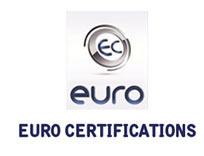

| Quality Management System of your Organization is critically important to you & your customers. Certification to requirements of ISO 9001:2008 is recognized as a tried & tested way of improving the company performance & ensuring that the customers are satisfied. It is also a benchmark for working towards & achieving business excellence. |
ISO 14001:2004-ENVIRONMENTAL MANAGEMENT SYSTEM (EMS)
| Certification to requirements of ISO 14001 is recognized as the best tool for controlling the environmental effects of your activities, products & services. It will enable you to comply with the applicable statutory & regulatory requirements also. Implementing the environmental management system as per the requirement of ISO 14001 will help you to improve Operational Efficiency for Cost Savings, Energy Conservation, and Reduce Environmental Liability & Improve Social Image. |
ISO 13485: 2003– QUALITY MANAGEMENT SYSTEM FOR MEDICAL DEVICES
| ISO 13485:2003 is an International Standard recognised for the Medical Device Regulations around the world. All requirements of ISO 13485 are specific to the organisations providing medical devices regardless of the type or size of the organisation. Whatever devices you produce, as a medical device manufacturer you have a responsibility to consistently deliver devices that are safe and effective. Adoption of this standard assures the customers that the product complies with all relevant product and service oriented technical standards and regulations. |
OHSAS 18001:2007 OCCUPATIONAL HEALTH & SAFETY MANAGEMENT SYSTEM
| OHSAS 18001 helps the organization to define the occupational health and safety policies and objectives including compliance to legal and other requirements. The organization can apply the standard to minimize risks, accidents and hazards, to improve employee motivation and involvement. Using professional assessment teams with in depth knowledge of your health & safety issues, the certification process will ensure that your management system meets the requirements of current Occupational Health & Safety Management Standards. |
ISO / IEC 20000-1:2011 INFORMATION TECHNOLOGY SERVICE MANAGEMENT SYSTEM:(ITSMS)
| ISO/IEC 20000 is the international standard for IT service management. This standard enables you to independently demonstrate to your customers that you meet best practice. This is applicable to any organization, large or small, in any sector or part of the world which relies on IT services. The standard is particularly applicable to internal / external IT service providers, IT departments and IT outsourcing organizations. ISO/IEC 20000 certification demonstrates that an organization has adequate controls and procedures in place to consistently deliver a cost effective, quality IT service. |
ISO / IEC 27001:2005 INFORMATION SECURITY MANAGEMENT SYSTEM (ISMS)
| Information is an important asset & is valuable to an organization and hence needs to be suitably protected. Information leaks enhance risk.ISMS outlines the best practices that one should follow to protect informational assets. ISMS is the only method that specifically addresses the protection of information. It provides detailed guidelines on how a secure management framework should be implemented. Recent high profile information security breaches and the value of information are highlighting the ever increasing need for organizations to protect their information. An Information Security Management Systems (ISMS) is a systematic approach to managing sensitive company information so that it remains secure. It encompasses people, processes and IT systems. |
ISO 22000: 2005 FOOD SAFETY MANAGEMENT SYSTEM (FSMS)
| FSMS – AN INTRODUCTION of FOUR KEY ELEMENTS |
| Management, Including Policy, Obligation, Organization and Resources: This content includes a corporate requirement to demonstrate effective internal communication within the company, and that the management should lead the way in doing this. There are also demands regarding communication to both suppliers and customers. This includes a definition of the systems necessary to ensure agreement between the expectations of sales staff and purchasers regarding products. |
|
|
| HACCP Plan and Principles: |
| Food safety is defined as the absence of risk factors above a certain acceptable level. By employing the well known HACCP principles, a decision is made as to where there are critical control points (CCPs) in the process, how these are to be monitored and how they can be brought back under control. The management system must be focused, which means the number of CCPs should be kept to a minimum. |
|
|
| Other Measures: |
| Other conditions that require control are described as “other measures”. These should be present, documented and working well to ensure the efficiency of the system. The standard describes how a controlling measure is categorized as regards CCPs and other measures, but does not include a decision tree. |
|
|
| Communication: |
| There are also demands regarding accessible information about products, storage conditions and the development of new foodstuffs and food products, as well as the education and training of staff whose work has an impact on food safety. HACCP (Hazard Analysis Critical Control Point) are the specifications which are internal and integrated part of ISO 22000:2005 standard. We can issue a separate certificate for HACCP if there is a need for the client at no extra cost. |
ISO 30000:2009 SHIP RECYCLING MANAGEMENT SYSTEM (SRMS)
| Certification to requirements of ISO 30000 is recognized as the best tool for controlling the environmental effects of your activities, products & services. It will enable you to comply with the applicable statutory & regulatory requirements also. Implementing the Ship Recycling Management System as per the requirement of ISO 30000 will help you to improve Operational Efficiency for Cost Savings, Energy Conservation, and Reduce Environmental Liability & Improve Social Image. |
ISO 50001:2011 ENERGY MANAGEMENT SYSTEM ( EnMS).
| The purpose of this International Standard is to enable organizations to establish the systems and processes necessary to improve energy performance, including energy efficiency, use and consumption. Implementation of this International Standard is intended to lead to reductions in greenhouse gas emissions and other related environmental impacts and energy cost through systematic management of energy. This International Standard is applicable to all types and sizes of organizations, irrespective of geographical, cultural or social conditions. Successful implementation depends on commitment from all levels and functions of the organization, and especially from top management. This International Standard specifies Energy Management System (EnMS) requirements, upon which an organization can develop and implement an energy policy, and establish objectives, targets, and action plans which take into account legal requirements and information related to significant energy use. An EnMS enables an organization to achieve its policy commitments, take action as needed to improve its energy performance and demonstrate the conformity of the system to the requirements of this International Standard. This International Standard applies to the activities under the control of the organization, and application of this International Standard can be tailored to fit the specific requirements of the organization, including the complexity of the system, degree of documentation, and resources |
WHO-GMP
| WHO-GMP is an acronym for WORLD HEALTH ORGANIZATION – GOOD MANUFACTURING PRACTICE is the specifications derived by world health organization.GMP is a sanitary and processing requirement applicable to all food processing establishments. Many food industry companies have implemented the GMP certification scheme for food processing as the foundation upon which they have developed and implemented other food quality assurance systems and food safety management systems, such as HACCP, ISO 9001 and ISO 22000 |
BRC – IOP
| BRC is an acronym for BRITISH RETAILER CONSERTIUM. The BRC Global Standards are a suite of four industry-leading Technical Standards that specify requirements to be met by an organisation to enable the production, packaging, storage and distribution of safe food and consumer products. Originally developed in response to the needs of UK members of the British Retail Consortium, the Standards have gained usage world-wide and are specified by growing numbers of retailers and branded manufacturers in the EU, North America and further afield. Certification to a Global Standard, which is achieved through audit by a third party Certification Bodies, reassures retailers and branded manufacturers of the capability and competence of the supplier, and reduces the need for retailers and manufacturers to carry out their own audits, thereby reducing the administrative burden on both the supplier and the customer. |
RoHS (Resctriction of Hazardous Substance):
| Restriction of Hazardous Substances. RoHS Directive 2002/95/EC restricts the use of six hazardous materials found in electrical and electronic products. All applicable products in the EU market must pass RoHS compliance. RoHS impacts the entire electronics industry. |
ATEX (ATmosphere EXplosible):
| Any control equipment used to ensure the safe operation of equipment in a hazardous area falls within the scope of the ATEX Directive (from the French – ATmospheres Explosibles). The ATEX Directive combines two European Directives associated with equipment used in and people who work in potentially explosive atmospheres. It not only considers potentially explosive concentrations of gas, vapour or mist in the air, but also concentrations of dust. It accounts for both electrical and mechanical sources of ignition. It also concerns the minimum requirements for improving safety and health protection of workers at risk from explosive atmospheres. An Explosive Atmosphere is the mixture of flammable substances in the form of gases, vapours, mists or dusts with air. |
CE MARKING
After successful completion of testing of product, we shall establish a technical documentation (Technical File) for the products to be covered for CE marking. The technical documentation must allow assessment of conformity of the product with the requirement of respective directives. It must include:
|
ISO 15408-1: 2009 INFORMATION TECHNOLOGY SECURITY TECHNIQUES
| ISO/IEC 15408-1:2009 establishes the general concepts and principles of IT security evaluation and specifies the general model of evaluation given by various parts of ISO/IEC 15408 which in its entirety is meant to be used as the basis for evaluation of security properties of IT products. It provides an overview of all parts of ISO/IEC 15408. It describes the various parts of ISO/IEC 15408; defines the terms and abbreviations to be used in all parts ISO/IEC 15408; establishes the core concept of a Target of Evaluation (TOE); the evaluation context; and describes the audience to which the evaluation criteria are addressed. An introduction to the basic security concepts necessary for evaluation of IT products is given. It defines the various operations by which the functional and assurance components given in ISO/IEC 15408-2 and ISO/IEC 15408-3 may be tailored through the use of permitted operations. The key concepts of protection profiles (PP), packages of security requirements and the topic of conformance are specified and the consequences of evaluation and evaluation results are described. ISO/IEC 15408-1:2009 gives guidelines for the specification of Security Targets (ST) and provides a description of the organization of components throughout the model. |
REACH
| R E A CH = Registration Evaluation Authorisation Chemicals REACH is the European chemicals legislation. It applies in all 27 EU countries plus Norway, Iceland and Liechtenstein. It does not apply in Switzerland |

